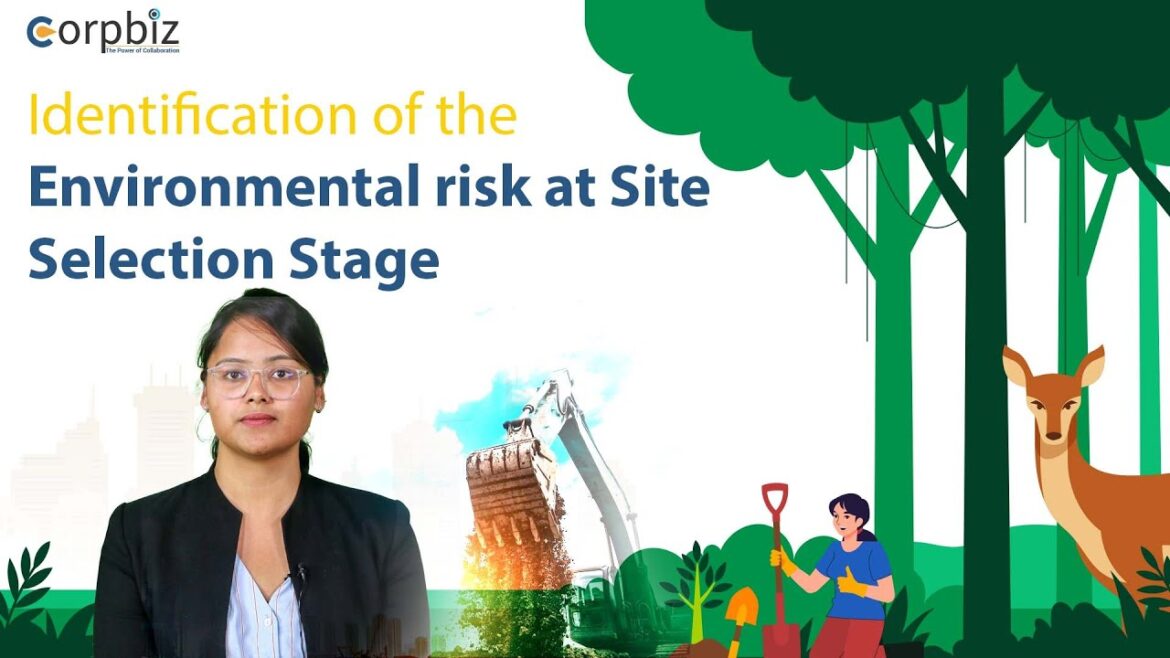As we have seen amidst growing concerns in the industry towards #environmental risks before constructing any building or industrial plant (Graphic Ideas: Construction of buidling or industries images/video) at the developmental area, one should evaluate the risk factors related to the environment for a better understanding at the site selection stage.
Why it’s needed (Need of Environmental risk at Site Selection Stage?
• To predict the environmental risk such as Natural disasters, soil quality, air quality, ground water and storm water flow etc.
• To Provide basic knowledge to take a good decision for sustainable resource development.
What are the Environmental Risks that influence #siteselection (Graphic Ideas: Lab photos, Pollution photos, Resettlement, Mountains, Forest, Earthquake, Dams, Highways, Airport)?
For the due diligence process, we have to keep in mind these environmental risk indicators such as
1. Soil Quality like Soil contamination, agriculture runoff, accidental chemical spills etc.
2. Water Quality such as Water contamination, Leachates runoff & other parameters
3. Past Cumulative Impacts such as air, noise, soil & water pollution.
4. Critically & severely polluted areas as per the #CPCB Guidelines.
5. Socio-Economic Risk: Rehabilitation and Resettlement.
6. Topographical pattern such as Low/High lying areas like Hilly, steep, Mountains etc.
7. Geological Features like soil, mineral and rock type.
8. Ecology & Biodiversity like National Park, Wildlife sanctuary, Native species, Alien Species etc.
9. Natural hazards like earthquakes, subsidence, landslides, Soil erosion, Landslide, flooding, or extreme or adverse climatic conditions.
10. Ground water table fluctuation (or Percolation rate)
11. Water bodies: wetlands, dams, rivers, oceans, lakes etc.
12. Land classification, i.e. private, government and agricultural land etc.
13. Livestock Grazing
14. Infrastructure facilities such as highways, roads, rail, ports, harbours, oil & gas pipelines, any defence installation, interstate and international boundaries etc.
15. Wind Direction (Upwind & downwind)
16. Eco-Sensitive area (EPA Act,1986)
How (Grading of Environmental Risk) can we grade any Environmental Risk?
Criteria for grading the risk set by the concerned authority into
1. Grade 1: Low Risk Grading
2. Grade 2: Low to Medium Risk Grading
3. Grade 3: Medium to High Risk Grading
4. Grade 4: High Risk Grading
The entire Process follows for Site Selection
The general site selection process will comprise the following stages:
• Firstly, we have to Define Study Area
• then proper screening of the Study Area will be needed
• Next Identification of suitable areas for sites through SWOT Analysis
• Next is Identification of Relevant issues of Concern such as environmental, socio-economic, project cost, soil quality, water quality, health, water contamination, biodiversity etc.
• Next is the Analysis of the risk by the Environmental Professionals and finally
• After analysing the risks, the proponent can take appropriate decision
What really happens when one neglects such Environmental Risk at the stage of Site Selection (Repercussion of Negligence of Environmental risk )?
The site selection stage this can permanently handicap the project’s revenues and profits, which will affect the project with respect to licenses such as
1. Refusal of Land permit from the concerned authority
2. Refusal of Environmental permissions & clearance such as Environmental Clearance, CTE/CTO etc.
3. Penalties/Fine levied by the authority.
How one can Mitigate Environmental Risk at the Site Selection Stage (How to mitigate environmental risk at site selection stage)?
Follow these steps such as:
1. Conduct a site survey to identify elements and create a master development plan.
2. Avoid deforestation, disruption of groundwater flows and other mitigation measures to minimise the ecological footprint.
3. Hire Environmental professionals, architects, geologists etc., to minimise and evaluate the environmental risk.
4. Select a site that meets green standards such as Use of sun’s energy in the daylighting, solar gain and natural lighting
5. Avoid the disturbance of any Wildlife habitat, Human Settlement, Forest area etc.
6. Avoid development in poorly located sites, i.e. wetlands, virgin native ecosystems, or restore native ecosystems.
7. Selection of the site should be made in a proper manner that reduces erosion and contamination
Know more: https://corpbiz.io/learning/environmental-risk-at-the-stage-of-site-selection/
Phone:- 7838392800
Email:- info@corpbiz.io
Want to know more about #Corpbiz?
Subscribe to our Corpbiz channel to get the latest updates, tips, and help. https://bit.ly/3w7AFJ5
Website: https://corpbiz.io
Facebook: https://www.facebook.com/corpbizhq
Twitter: https://www.twitter.com/corpbizhq
Instagram: http://instagram.com/corpbizhq
LinkedIn: https://www.linkedin.com/company/corpbizhq

